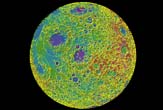Moon's Face Reveals Extreme Cosmic Abuse

The moon's pimpled face is a testament to the serious beating it's received over the years from incoming space rocks, and a new study has found just how severe that lunar smackdown has been.
Scientists have compiled the first comprehensive catalog of large craters on the moon to document its cosmic abuse. They've also made a detailed study of minerals on the moon and identified areas of unusual silica-rich composition, in a pair of related studies.
"For the first time we're actually detecting how complex the lunar surface is," said planetary scientist Benjamin T. Greenhagen of NASA's Jet Propulsion Laboratory in Pasadena, Calif., leader of one of the mineralogy studies. "It's a bit of a paradigm shift." [See the new moon map]
The new findings are detailed in threepapers in the Sept. 16 issue of the journal Science.
Mapping the holes
In a second study, scientists built a new lunar crater map with data from the Lunar Orbiter Laser Altimeter instrument on NASA's Lunar Reconnaissance Orbiter,which includes 5,185 craters that are 12 miles (20 km) in diameter or larger.
The database provides a window on the past, revealing which parts of the moon are most pockmarked, and therefore represent older surfaces, and which areas have been covered over with fresh material by volcanism relatively recently. The researchers discovered that the moon's oldest regions are the southern near side and the north-central far side.
Get the world’s most fascinating discoveries delivered straight to your inbox.
One feature, the South Pole-Aitken basin, appears to be the oldest basin on the moon. As such, it could offer unique clues about the moon's history, and the story of the early solar system in general.
The findings "are telling us something about the infancy of the solar system," said the study's leader James W. Head III, a planetary geologist at Brown University, in a statement. "It is clear we can find out and learn so much more from future missions, robotic or otherwise. There is so much to do."
Rare moon minerals
Researchersused the Diviner Lunar Radiometer Experiment, also on the Lunar Reconnaissance Orbiter, to measure the infrared light coming from the moon in several frequencies. Long-wavelength infrared light is heat energy, and it can give researchers information about some of the mineral content of the lunar surface not available from visual or other-wavelength observations.
In particular, the scientists looked for areas rich in silica (made of the chemical compound other formations. This compound is relatively rare on the moon, and requires a particular volcanic process for creation.
The team found five spots on the moon rich in silica, showing that this mineral does exist on the moon, but is indeed rare.
A third team of researchers, led by Timothy D. Glotch of New York's Stony Brook University, honed in on some of these spots and found that the silica on the moon is likely quartz, silicon-rich glass or alkali feldspar.
"The silica-rich materials have actually been proposed to be on the surface in these locations, but we have never sent an instrument that could detect them before," Greenhagen told SPACE.com. "It's important to know the silica-rich regions because they require a very specific type of crustal evolution."



